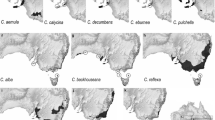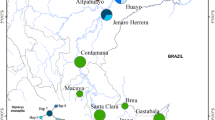Abstract
Black cherry (Prunus serotina) is a tree from North America, where it is often used for economical purposes, whereas it is widespread and invasive in Europe. Plastid DNA variation was first investigated in both its native and invasive ranges using microsatellite loci and sequences of three intergenic spacers (trnT-trnL, trnD-trnT and trnS-trnG). This analysis was focused on P. serotina var. serotina, with the inclusion of samples of closely related taxa. Length variation at a microsatellite locus (ccmp5) and a few sequence polymorphisms were identified among P. serotina samples. Four new primer pairs were then designed to specifically amplify variable regions and a combination of five markers was finally proposed for phylogeographic studies in P. serotina. These loci allow identification of six chlorotypes in P. serotina var. serotina, which may be particularly useful to depict the maternal origins of European invasive populations.


Similar content being viewed by others
References
Bandelt HJ, Forster P, Röhl A (1999) Median-joining networks for inferring intraspecific phylogenies. Mol Biol Evol 16:37–48
Basic N, Besnard G (2006) Gene polymorphisms for elucidating the genetic structure of the heavy-metal hyperaccumulating trait in Thlaspi caerulescens and their cross-genera amplification in Brassicaceae. J Plant Res 119:479–487. doi:10.1007/s10265-006-0011-x
Besnard G (2008) Chloroplast DNA variations in Mediterranean olive. J Hortic Sci Biotechnol 83:51–54
Brettin TS, Karle R, Crowe EL, Iezonni AF (2000) Chloroplast inheritance and DNA variation in sweet, sour and ground cherry. J Hered 91:75–79. doi:10.1093/jhered/91.1.75
Broennimann O, Treier UA, Müller-Schärer H, Thuiller W, Peterson AT, Guisan A (2007) Evidence of climatic niche shift during biological invasion. Ecol Lett 10:701–709. doi:10.1111/j.1461-0248.2007.01060.x
Demesure B, Sodzi N, Petit RJ (1995) A set of universal primers for amplification of polymorphic non-coding regions of mitochondrial and chloroplast DNA in plants. Mol Ecol 4:129–131. doi:10.1111/j.1365-294X.1995.tb00201.x
EPPO (2007) List of invasive alien plants (accessed on 12/17/2007 from http://www.eppo.org/QUARANTINE/ias_plants.htm)
Freeman JS, Marques CMP, Carocha V, Borralho N, Potts BM, Vaillancourt RE (2007) Origins and diversity of the Portuguese Landrace of Eucalyptus globulus. Ann For Sci 64:639–647. doi:10.1051/forest:2007042
Godefroid S, Phartyal SS, Weyembergh G, Koedam N (2005) Ecological factors controlling the abundance of non-native invasive black cherry (Prunus serotina) in deciduous forest understory in Belgium. For Ecol Manag 210:91–105. doi:10.1016/j.foreco.2005.02.024
Goudet J (2005) Fstat (version 2.9.4): a program to estimate and test population genetics parameters. http://www2.unil.ch/popgen/softwares/fstat.htm
Harbourne ME, Douglas GC, Waldren S, Hodkinson TR (2005) Characterization and primer development for amplification of chloroplast microsatellite regions of Fraxinus excelsior. J Plant Res 118:339–345. doi:10.1007/s10265-005-0223-5
Hough AF (1965) Black Cherry (Prunus serotina Hehrh.). Silvics of forest trees of the United States. In: Fowells HA (ed) Agricultures handbook 271. US Department of Agriculture, Washington, DC, pp 539–545
Little EL Jr (1971) Atlas of United States trees, vol 1, conifers and important hardwoods. US Department of Agriculture Miscellaneous Publication No. 1146, Washington
Magri D, Fineschi S, Bellarosa R, Buonamici A, Sebastiani F, Schirone B, Simeone MC, Vendramin GG (2007) The distribution of Quercus suber chloroplast haplotypes matches the palaeogeographical history of the western Mediterranean. Mol Ecol 16:5259–5266
Marquis DA (1975) The Allegheny hardwood forests of Pennsylvania. USDA Forest Service, general technical report NE-15. Northeastern Forest Experiment Station, Upper Darby, 32p
Mau-Crimmins TM, Schussman HR, Geiger EL (2006) Can the invaded range of a species be predicted sufficiently using only native-range data? Lehmann lovegrass (Eragrostis lehmanniana) in the southwestern United States. Ecol Model 93:736–746. doi:10.1016/j.ecolmodel.2005.09.002
McVaugh R (1951) A revision of the north American black cherries (Prunus serotina Ehrh., and relatives). Brittonia 7:279–315. doi:10.2307/2804698
Mohanty A, Martín JP, González LM, Aguinagalde I (2003) Association between chloroplast DNA and mitochondrial DNA haplotypes in Prunus spinosa L. (Rosaceae) populations across Europe. Ann Bot (Lond) 92:749–755. doi:10.1093/aob/mcg198
Pairon M, Chabrerie O, Mainer Casado C, Jacquemart AL (2006) Sexual regeneration traits linked to black cherry (Prunus serotina Ehrh.) invasiveness. Acta Oecol 30:238–247. doi:10.1016/j.actao.2006.05.002
Pairon M, Jacquemart AL, Potter D (2008) Detection and characterization of genome-specific microsatellite markers in the allotetraploid Prunus serotina. J Am Soc Hortic Sci 133:390–395
Petit RJ, Duminil J, Fineschi S, Hampe A, Salivini D, Vendramin GG (2005) Comparative organization of chloroplast, mitochondrial and nuclear diversity in plant populations. Mol Ecol 14:689–701. doi:10.1111/j.1365-294X.2004.02410.x
Shaw J, Small RL (2004) Addressing the ‘hardest puzzle in American pomology:’ phylogeny of Prunus sect. Prunocerasus (Rosaceae) based on seven noncoding chloroplast DNA regions. Am J Bot 91:985–996. doi:10.3732/ajb.91.6.985
Starfinger U (2006) NOBANIS—invasive alien species fact sheet—Prunus serotina. Online database of the North European and Baltic network on invasive alien species (accessed on 12/17/2007 from www.nobanis.org)
Starfinger U, Kowarik I (2003) Prunus serotina Ehrh. (Rosaceae), Späte Traubenkirsch. Neoflora fact sheet (accessed on 01/22/2008 from http://www.floraweb.de/neoflora/handbuch/prunusserotina.pdf)
Taberlet P, Gielly L, Pautou G, Bouvet J (1991) Universal primers for amplification of three non-coding regions of chloroplast DNA. Plant Mol Biol 17:1105–1109. doi:10.1007/BF00037152
Vendramin GG, Fady B, González-Martínez SC, Sheng Hu F, Scotti I, Sebastiani F, Soto A, Petit RJ (2008) Genetically depauperate but widespread: the case of an emblematic Mediterranean pine. Evolution Int J Org Evol 62:680–688. doi:10.1111/j.1558-5646.2007.00294.x
Weising K, Gardner RC (1999) A set of conserved PCR primers for the analysis of simple sequence repeat polymorphisms in chloroplast genomes of dicotyledonous angiosperms. Genome 42:9–19. doi:10.1139/gen-42-1-9
Acknowledgments
This research was funded by the National Centre of Competence in Research (NCCR) Plant Survival, research program of the Swiss National Science Foundation. M. Pairon and A.L. Jacquemart were supported by the Fonds Spéciaux de Recherche (FSR) of the Université catholique de Louvain (UCL) and the Belgian Scientific Policy (BelSPo-InPlanBel). M. Pairon is research fellow of the Belgian National Fund of Scientific Research and A.L. Jacquemart is research associate in the same institution. Collection of the samples was partly funded by grants to K.O. Reinhart from Highlands Biological Station and from the A.W. Mellon Foundation helping form a partnership between the National Park Service, the Ecological Society of America and the National Park Foundation. We are grateful for the kind collaboration of many foresters and scientists who helped collecting leaves of P. serotina and P. virginiana: P.J. Alexander and D. Bailey (New Mexico State University), M. Campbell (Pennsylvania State University), F. Caronni and L. Hildebrand (Parco Lombardo della Valle del Ticino), G. Decocq (University of Picardie), R.B. Kaul and D.M. Sutherland (University of Nebraska), R.A. Klips (Ohio State University), P. Jenkins and J. Tedford (University of Arizona), D.A. Lewis (Iowa State University), N.P. Revsbech (University of Aarhus). We also thank D. Potter and an anonymous reviewer for their constructive comments.
Author information
Authors and Affiliations
Corresponding author
Additional information
Communicated by R. Matyssek.
Rights and permissions
About this article
Cite this article
Petitpierre, B., Pairon, M., Broennimann, O. et al. Plastid DNA variation in Prunus serotina var. serotina (Rosaceae), a North American tree invading Europe. Eur J Forest Res 128, 431–436 (2009). https://doi.org/10.1007/s10342-009-0287-1
Received:
Revised:
Accepted:
Published:
Issue Date:
DOI: https://doi.org/10.1007/s10342-009-0287-1




